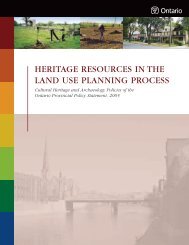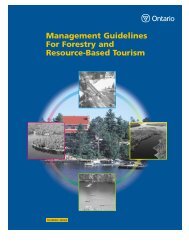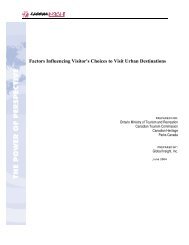Heritage Conservation Principles for Land Use Planning
Heritage Conservation Principles for Land Use Planning
Heritage Conservation Principles for Land Use Planning
Create successful ePaper yourself
Turn your PDF publications into a flip-book with our unique Google optimized e-Paper software.
• InfoSheet •<br />
<strong>Heritage</strong> <strong>Conservation</strong> <strong>Principles</strong> <strong>for</strong> <strong>Land</strong>use <strong>Planning</strong><br />
Retention<br />
The decision making process should always presume in favour of retaining<br />
the heritage resource. The only exception to this rule is when there is a<br />
demonstrated public benefit of greater importance than the protection of the<br />
heritage resource.<br />
The significance, type, use and condition of a resource should be considered<br />
as part of the decision making process. Only allow changes that will offer the<br />
least harm to the resource or will provide the greatest potential to enhance its<br />
significance and appreciation.<br />
Where negative impacts are unavoidable, effective mitigation must be applied<br />
including reusing and making sympathetic alterations, reconstruction, moving<br />
to an appropriate setting, commemoration on site or elsewhere, or recording<br />
the resource be<strong>for</strong>e any negative changes are made.<br />
Caution<br />
Avoid decisions that will damage or harm the fabric of cultural heritage<br />
resources and their settings. <strong>Use</strong> approaches that offer the least risk to the<br />
fabric of the resource. Consider sympathetic alterations or reversible changes<br />
to it.<br />
Give priority to measures that improve conditions <strong>for</strong> long-term conservation:<br />
focus on maintenance of parts, setting, function or use.<br />
Ensure that approaches proposed <strong>for</strong> conservation have been proved reliable<br />
and effective and that they constitute good practice.<br />
Public Benefit<br />
To understand and appreciate cultural resources, the public should be<br />
provided with accurate interpretation of the resource, through in<strong>for</strong>mation that<br />
effectively communicates the importance and value of the resource.<br />
The in<strong>for</strong>mation contained in this InfoSheet should not be relied upon as a substitute<br />
<strong>for</strong> specialized legal or professional advice in connection with any particular matter.<br />
© Queen's Printer <strong>for</strong> Ontario, 2007.<br />
If credit is given and Crown copyright is acknowledged, this material may be<br />
reproduced <strong>for</strong> non-commercial purposes. Page 2 of 2



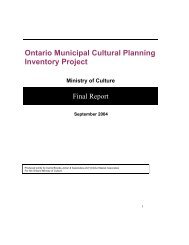
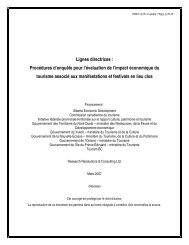
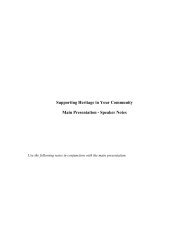
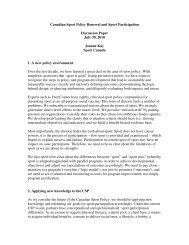
![THIS AGREEMENT made this [date], between [name of owner] (the ...](https://img.yumpu.com/49827605/1/158x260/this-agreement-made-this-date-between-name-of-owner-the-.jpg?quality=85)


